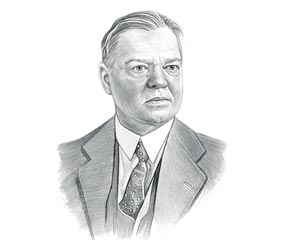|
|
|
|
|
The public outcry was so great that the federal government were seriously considering the establishment of a national censorship board. To prevent this happening Hollywood moguls and the movie studios decided to voluntarily censor films themselves.
Hays Code: The
Code to Govern
the Making of
Talking and
Silent Motion
Pictures What was the Hays Code? The Hays Code was a list of guidelines and rules called "The Don'ts and Be Carefuls" that were voluntarily applied as a form of censorship by the Hollywood movie industry. The Hays Code was called "the motion picture industry's Magna Charta of official decency." What date did the Hays Code start and end? The Hays Code censorship rules were formulated in 1929, presented in 1930 and were rigidly enforced by 1934. The Hays Code was in place until 1965. What was the Purpose of the Hays Code? The Purpose of the 1930 Hays Code was to establish a voluntary self-censoring system for the production of movies and to improve the image of Hollywood thus avoiding the creation of a national censorship board by the Federal Government. Why was the Hays Code abandoned? The Hays Code was abandoned in 1965 in favor of the age-based rating system that was adopted by the MPPDA which is still in force today.
The Hays Code
The Hays Code
- General Principles
The Hays
Code - Particular
Applications
The Hays
Code - The
Preamble
The Hays
Code - The
Official
Name
The Hays
Code - Enforcement
The Hays
Code - Penalties
The Hays
Code and
American
Movies Facts about
Hays Code The Hays Code required that women, in love scenes, at all times have "at least one foot on the floor" (in other words, no love scenes in bed). People could not be in a horizontal position if they were kissing. The Outlaw: The 1943 movie "The Outlaw" starring Jane Russell and produced by Howard Hughes had 30 seconds cut from the movie which showed too much of the stars cleavage. Betty Boop: The Flapper image of even the cartoon character Betty Boop had to be 'cleaned up' due to the strict rules. Her skirts were lengthened to the knee, her garter belt was replaced with leg-covering stockings and the necklines of her dress were raised, so as not to cause offence. Betty Boop even lost some of her curls and her famous, trademark winks and shaking hips were deemed to be "suggestive of immorality". Betty Boop had to portray a demure image. The censorship of Betty Boop was probably the most extreme example of the rigidity of the Hays Code. The image shows Betty Boop as she looked before she was transformed by the regulations, which led to the ruin of her career. It Happened One Night: The 1934 movie 'It Happened One Night' was one of the first movies to follow the Hays Code and "no scenes of passion". The characters played by Claudette Colbert and Clark Gable spend a night together at a motel but a blanket divider separates the room into two sections and Colbert wears prudish pajamas. Film Noir: Film Noir is a movie genre that generally depicts disillusioned and desperate characters in the world of corruption and criminal activities often depicting murder and theft. The characters and plot lines of the Film Noir conflicted with the ethics promoted by the Hays Code. The Maltese Falcon (1941) - Film Noir: The Maltese Falcon suffered censorship in several ways. The characterization of Joel Cario, played by actor Peter Lorre, demanded he appeared being less "pansy". The moral code demanded that any inference of sex between Spade (Humphrey Bogart) and Brigid (Mary Astor) was removed. And that the consumption of alcohol was reduced. The Postman Always Rings Twice (1946) - Film Noir: The themes and story were changed for the Postman Always Rings Twice movie which had originally dealt with adultery, murder for lust with no signs of remorse. The code prohibited portrayals of clergy that made them appear corrupt or foolish and the occupations of characters movie versions of famous stories, such as Pride and Prejudice, were changed to accommodate this rule. Mr. Collins in the 1940 Pride and Prejudice became a librarian and Cardinal Richelieu in the 1948 adaptation of The Three Musketeers became a Prime Minister. Gone with the Wind: Profanity of any kind was prohibited which was a matter of huge contention in Gone with the Wind and whether Rhett Butler, played by Clark Gable, would be allowed to say "Frankly, my dear, I don't give a damn". Rhett Butlers famous line in Gone with the Wind was allowed when Hollywood producer David O. Selznick convinced Hays and Breen that the line, that was in Margaret Mitchell's famous novel, was not prejudicial to public morals. |
| US American History |
| 1929-1945: Depression & WW2 |
|
|
|
|
|
First Published2016-04-19 | |||
|
Updated 2018-01-01 |
Publisher
Siteseen Limited
| ||
|
|

